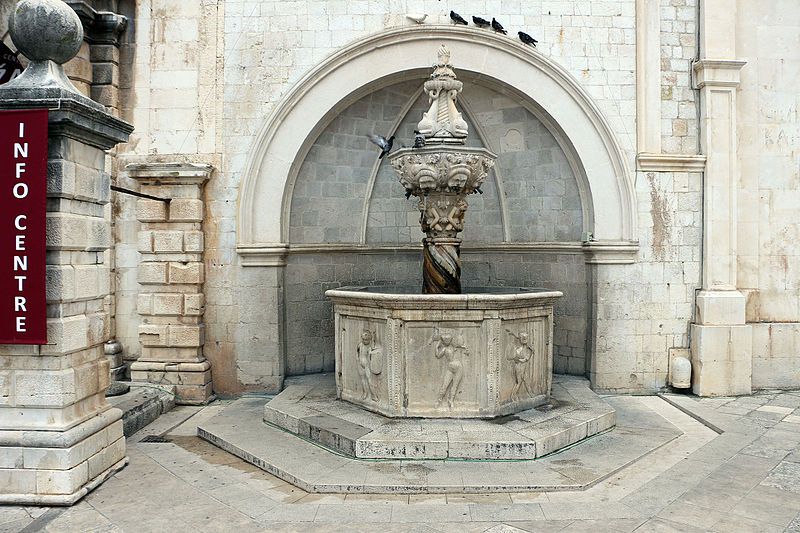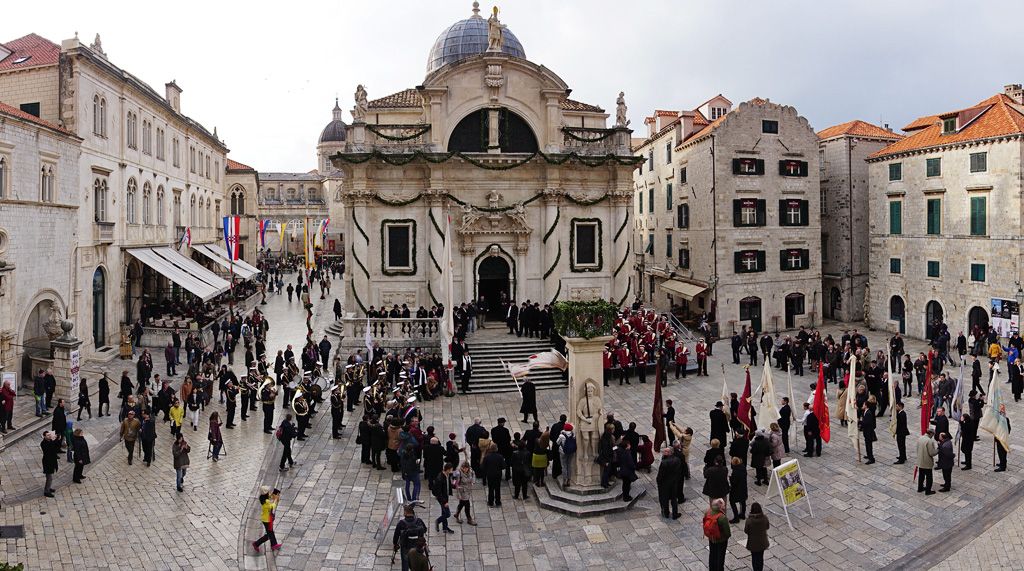Has Croatia Ruined its Oysters? According to an Expert, Apparently...
Have Croats managed to destroy their beloved Ston oysters with feces? Maybe. It sounds like another negative and inflammatory headline about how nobody can do anything right, but according to one respected expert, this might really be the case.
Norovirus is a potentially dangerous virus of the Caliciviridae family which causes 19 to 21 million illnesses, 56,000 to 71,000 hospitalisations and as many as 570 to 800 deaths per year according to the Centres for Disease Control and Prevention. Often called stomach flu, Norovirus is highly contagious, and is known to mercilessly tear through populations of people in concentrated areas, cruise ships are a particular favourite playground for the virus.
Symptoms, which include chronic vomiting and diarrhoea can become very severe very quickly, rendering a person unable to hold anything down, eventually leading to extreme weakness, sudden weight loss, dehydration, and the need for emergency treatment. Now we've covered the basics of this microscopic devil, how has the presence of Norovirus managed to infiltrate Ston's long oyster-based traditions? Perhaps more importantly, just how have the Croats succeeded in allowing such danger to seriously threaten Ston's most prized gastronomic offer?
As Index writes on the 5th of March, 2019, Vlado Onofri, a scientific advisor at the University of Dubrovnik spoke to Libero portal and explained that the Croats have indeed managed to destroy southern Dalmatia's internationally adored gourmet delicacy. He said that the cause was the unsolved issue of the area's sewage network, more specifically septic tanks that are full, and not being emptied. Such conditions lead to the presence of potentially dangerous viruses and bacteria, including the potentially fatal Norovirus.
Because of the presence of Norovirus on three of the five control points on which Ston's beloved oysters are grown, the Day of Mali Ston Oysters, which was supposed to take place on March the 16th, has now been cancelled for health and safety reasons.
"I'm sorry for the hospitality and catering facilities and for oyster lovers, I know they'll lose out on a lot because of this, but some things need to be said in order to start sorting things out," said Vlado Onofri rather bluntly, who claims that when it comes to Croatia's very unfortunate oyster situation, there's nobody to blame but the Croats themselves.
"There will certainly be a reaction after all of this, but come on, have someone show me that they've paid for the emptying of the septic tanks! Nobody will show you that! Except the Koruna restaurant, which I know keep their oysters in pools and they're absolutely fine for consumption. That's the only example [of that] in Ston.
The entire area hasn't had its sewage situation solved adequately, and it was the obligation of the state to resolve it at the beginning of the eighties when the sewage [system] was being done. Mali Ston and Veliki Ston were meant to be connected to the entire sewage system, this wasn't done and now after so many years, it's time to pay! You know how it goes with septic tanks, when there were small households, there were small quantities, but now there's a lot more, it's all too full up, and nobody is emptying them!" Onofri said.
This isn't the first time a virus has appeared in these oysters.
"Three years ago, there was a problem. People got food poisoning, started having diarrhoea, vomiting... that's Norovirus, viruses aren't harmless things, that virus can live for hundreds of years in sludge, when it comes across live tissue, it becomes virulent again (a pathogen's ability to infect its live host) because it crystallises its capsomer (a covering of protein that protects the genetic material of a virus). I'm good with virology and I know what I'm talking about because I did a Master of Science in the 1980s, and later a doctorate in Ston,'' Onofri explained, backing up his claims.
"We're dependant on the whims of humans and nature"
He also provided a response to the question of how long this dire situation might last:
"The oysters can quickly get rid of the virus if they're in clean water, meaning that we need purification pools that we don't have. There was an idea to make them in Bistrina, and I personally brought plans from France to show what this should look like. There were ideas thrown around about doing that, but it hasn't been done. This is an absolute necessity, for when such things do happen, to end up with a sanitised and proper product. Now we're depending on the whims of humans and nature when it comes to how our products end up! The pools weren't made because of a protected reserve where nothing at all can be constructed,'' stated Onofri.
Make sure to stay up to date by following our dedicated lifestyle page.
Dubrovnik-Neretva County Hands Mljet First Firefighting Vessel
Mljet has been given the responsibility of caring for Dubrovnik-Neretva County's very first firefighting boat, which has been procured thanks to EU funds.
As Morski writes on the 2nd of March, 2019, Dubrovnik-Neretva County prefect Nikola Dobroslavić handed over the first firefighting vessel in Dubrovnik-Neretva County in Dubrovnik's port on Friday. The vessel is named Sveti Florijan, named after the patron saint of Linz.
The vessel was handed over by the prefect to the mayor of Mljet, Đivo Marketa, who immediately presented and subsequently handed it over to commander of Mljet's fire brigade, to Mario Dabelić.
Prefect Nikola Dobroslavić stressed that this is an excellent example of good use of the money made available to Croatia from European Union funds.
''The ship is largely financed by EU funds through a project conducted by Dubrovnik-Neretva County. This is the first firefighting boat in our county, and JVP Mljet (Mljet fire brigade) will be responsible for it, but of course it will be available to the whole of this southern area. Another firefighting vessel is coming to the City of Dubrovnik soon and this is a significant addition to the safety and the possibility of interventions being made at sea. This ship will be used for firefighting on boats, as well as in some other emergency situations,'' stated Dobroslavić, among other things.
Sveti Florijan is the first firefighter in Dubrovnik-Neretva County, otherwise Croatia's southernmost county, area acquired by the southern Dalmatian county as part of the scope of the European project AdriaMORE, which is otherwise one of the projects currently being implemented by the Interreg Croatia-Italy cross-border program.
The project activities of Dubrovnik-Neretva County are worth around 350,000 kuna, of which 85 percent are being co-financed with the very welcome funds of the European Regional Development Fund, and the remaining 15 percent are financed by the county's own funds.
A shipbuilding contract, worth about 950,000 kuna, was signed last September with Damor d.o.o., and, as previously mentioned, the new firefighting vessel will be taken care of by Mljet's fire brigade and by Mljet Municipality.
Dubrovnik-Neretva County organised the ceremony as part of the activities on this year's International Civil Protection Day, which was marked on March the 1st.
Make sure to stay up to date by following our dedicated lifestyle page. If it's just Dubrovnik and southern Dalmatia you're interested in, give Total Dubrovnik a follow.
26 Million Kuna Allocated for Research in Sea in Šibenik-Knin County
As Frane Saric/VL/Poslovni Dnevnik writes on the 24th of February, 2019, a research and exploration vessel sailed to Šibenik-Knin County, along with all of its modern and sophisticated equipment, in order to properly track what is happening in the sea in that area of Dalmatia.
The Nature of Šibenik-Knin County (Priroda) public institution, in cooperation with the Institute of Oceanography and Fisheries in Split has begun with numerous activities of scientific monitoring in the area of the ecological network "Natura 2000 Ušće Krke", covering the area from Skradinski buk to the historic St. Nicholas Fort.
Šibenik-Knin County reported on the move and pointed out that the well-equipped IB BIOS DVA exploratory vessel is 36 metres in length, and is currently in Šibenik's waters. With an array of highly sophisticated equipment, it can explore complex physical, chemical and biological processes going on under the sea in the area.
"This important research, as part of the project worth more than 26 million kuna, will be carried out by a large number of scientists from the field of physical, chemical and biological oceanography of the Institute of Oceanography and Fisheries, and this will showcase the situation in the Natura area under the great pressure of tourism, maritime traffic, and construction,'' said Anita Babačić Ajduk of the aforementioned public institution.
The results of the monitoring will, as the county has already stated, serve as the basis for the popular-scientific presentation and an attractive exhibition in the city's future visitor centre.
The sheer importance of scientific research as the first step in tourism valorisation projects in this area was greatly emphasised, and Šibenik-Knin County has stated that the contract is worth 500,000 kuna. The contract is part of a local tourism valorisation project, which includes sampling and carrying out an analysis of the data with the aim of making an initial assessment of the status of the biological and oceanological indicators in that area.
The aim of the project is to preserve the biological and landscape diversity of Šibenik's underwater area, increase the area's attractiveness and educational capacity, and improve the tourist and economic potential, as was reported from Šibenik-Knin County.
Through this project, there will, as has already been mentioned, be more visitor infrastructure arranged, and a range of new tourist products will be created with the help of the upcoming introduction of brand new educational and information content.
Make sure to stay up to date with more of what's going on in Šibenik-Knin County and beyond by following our dedicated lifestyle page.
Click here for the original article by Frane Saric/VL on Poslovni Dnevnik
Bura Wreaks Havoc in Dalmatia, Split Records Strongest Winds Ever!
On Friday morning at around 4 am, the strongest bura wind in the history of meteorological measurements in Split was measured at Marjan. At that time, the brutal bura reached 176 km/h (48.9 m/s), which is the highest known wind speed ever measured in Split, reports Index.hr on February 23, 2019.
The average winds at that time were 118 km/h (33 m/s). The bura wiped out numerous trees and branches on Marjan, as is evidenced by the scenes near the former zoo, which you can see at Dalmacija Danas.
It is officially the strongest bura since November 14, 2004, when the strongest winds reached 174.6 km/h (48.5 m/s) during the cyclone Dorothy.
Three fires even broke out on Friday night. The first fire hit Split on Friday night, followed by one in Makarska. At about 5 am this morning, another fire occurred in Solin. The winds also ripped off the roof of a greenhouse in Solin over the night, which flew into busy traffic. Fortunately, the object was quickly removed and the traffic normalized.
The Split Police sent out an announcement this morning in response to the many calls they received over the night.
"During the night in the area of Split-Dalmatia County, and especially in the City of Split, we recorded many reports about trees on the roads, vehicle damage, damage to windows on buildings, and the like, all because of the strong winds. The police officers, together with the firefighters, were on the ground all night and acted on alerts. At this moment, we have not received a notification or know that anyone has been hurt during the event. We assume that throughout the morning we will receive further reports of material damage to objects and vehicles during the night.”
The bura also wreaked havoc on the roads.
Due to strong winds, the following roads are closed for all groups of vehicles:
Highway A1 between Posedarje and Sveti Rok, DC27 and DC50 via Karina, Obrovac and Gračac, the A6 Rijeka-Zagreb highway between Kikovica and Delnice, DC3 - old road through Gorski Kotar, state road DC54 Maslenica - Zaton Obrovački, Dr. Franjo Tudjman bridge near Dubrovnik, Mokošica-Komolac-Dubrovnik.
The following roads are open only for passenger vehicles:
Highway A6 Rijeka-Zagreb between Čavle and Kikovica, Adriatic Highway (DC8) between Novi Vinodolski and Senj, Karlobag and Svete Marije Magdalene, Pag bridge (DC106).
On the fast road Solin-Klis (DC1), the A7 motorway Draga-Šmrika, the local road Križišće-Kraljevica (LC58107) traffic for buses, caravans and motorcycles (Group I) is prohibited. On the Adriatic highway (DC8) between Bakar and Novi Vinodolski and Senj and Karlobag, there is a ban on delivery vehicles and vehicles with covered cargo spaces (Group I and II).
Due to a fire on the Adriatic Highway (DC8) at Jasenovo, only one lane is open.
ZC6246 Drniš-Roški slap is closed for all traffic due to trees on the road.
To read more about news in Croatia, follow TCN’s dedicated page.
Severe Weather Alert for Dalmatia: Brutal Bura to Hit Saturday
The Croatian Meteorological Institute (DHMZ) has issued the highest warning level for Split and Dalmatia on Saturday as the bura comes back with a vengeance.
A red alert has been marked for Split and the entire Dalmatia region. Split, and the surrounding areas will see gusts of wind reaching 110 kilometers per hour, with an average speed of 90 kilometers per hour on Saturday. A sudden change in the weather is expected from Friday afternoon, reports Slobodna Dalmacija on February 22, 2019.
“Be careful. There is a risk for personal safety due to fallen trees, broken branches, and flying debris. Widespread structural damage, interruption of traffic and power failures are expected,” warns DHMZ.
DHMZ alerts that this severe weather for Dalmatia poses a danger for health hazards and life-threatening situations, especially for sailors.
“There is also a significant risk of damage to coastal infrastructure. Be aware of the dangers, and pay attention and follow the latest weather reports. We advise the public to avoid traveling and coastal areas. It is very likely that the ferries will not operate, so if you are traveling, follow traffic information,” emphasizes DHMZ
DHMZ also predicts that temperatures will drop below zero.
Be careful out there!
To read more about news in Croatia, follow TCN’s dedicated page.
Statements about "Italian" Istria and Dalmatia Raise Concern
ZAGREB, February 11, 2019 - The Croatian Parliament Deputy Speaker and vice president of the Croatian Democratic Union (HDZ), Milijan Brkić, on Monday condemned a revisionist statement by European Parliament President Antonio Tajani about “Italian” Istria and Dalmatia, saying "God forbid Italians should care about Dalmatia and Istria the way fascists cared about the Croat people in Dalmatia and Istria."
"The Croatian people is very familiar with the fate that befell us in World War II and God forbid that Italians should care about Dalmatia and Istria the way fascists cared about the Croat people in Dalmatia and Istria," Brkić told a press before a meeting of the HDZ presidency and the National Council when asked to comment on Tajani's statement.
Brkić said Tajani should "sell those ideas of his somewhere else because no-one in Croatia will buy them."
"This is the Croatian state, a lot of blood was spilled for it. It was created in the Homeland War, and Croatian veterans and its people will most definitely not allow that," Brkić said.
Tajani spoke at an event commemorating foibe victims in Bosovizza.
Foibe are karst pits in Istria, Croatia and part of northern Italy into which the bodies of Italians, killed by the Partisans at the end and after WWII, were dumped. Italy remembers the victims on February 10.
Tajani reportedly said, "Long live Italian Istria! Long live Italian Dalmatia!"
More news on the relations between Croatia and Italy can be found in the Politics section.
Dubrovnik Police Handed 43.8 Kilograms of Marijuana
A suspicious discovery as Dubrovnik police discover sodden packets of marijuana washed up in and around the city.
During the winter along the southern Dalmatian coast, numerous rather odd objects and suspicious packages end up being washed up. From waste dragged up by the strong currents from the south ending up caught in Dubrovnik's harbour, to packets of marijuana lying around on the beach, Dubrovnik plays host to some unusual debris at this time of year.
Marijuana has been discovered by people just going about their business on several occasions along the southern Dalmatian coast, where it appears to have been dropped typically by passing vessels travelling between Albania and Montenegro and Italy.
It appears that the mysterious marijuana packages have returned, as Dubrovnik police end up receiving yet more discoveries from the shoreline.
As Morski writes on the 4th of February, 2019, last weekend, Dubrovnik police found two sea soaked packages of marijuana with a total weight of 43.8 kg in two different locations, more specifically the seafront in Dubrovnik itself and considerably further away on the island of Šipan, which is part of the picturesque Elaphite islands that lie just north of Dubrovnik.
The discovered packets of marijuana are now being stored at the official premises of the Dubrovnik Police Administration, after which their destruction will follow.
The Dubrovnik-Neretva Police Administration, with the help of international police cooperation, is currently conducting a proper criminal investigation into the discovered packages in order to attempt to determine the origin of the packages, according to a statement made by the Dubrovnik Police Administration.
Discoveries such as this one give the term sea weed an an entirely new meaning.
Make sure to stay up to date with everything you need to know going on up and down the country by following our dedicated news page. If it's just Dubrovnik and southern Dalmatia you're interested in, give Total Dubrovnik a follow to keep up with what's going on in the Pearl of the Adriatic.
Dubrovnik Highway: Talk of 800 Million Euro Project Reignited
After a decade of silence and complete inactivity, the Croatian Government is moving once again towards the temptation of a highway construction project towards Dubrovnik, a move initially started by former PM Ivo Sanader.
As Kresimir Zabec/Novac writes on the 2nd of February, 2019, after a rather unnecessarily lengthy and of course unclear title, the conclusion of the ''study documentation for the road connection of southern Dalmatia to the motorway network system of the Republic of Croatia from the Metković junction to the future Pelješac bridge and from the Doli junction to the City of Dubrovnik'' (yes you can take a breath now), which was adopted during Friday's Government session held in Dubrovnik, has actually led back to the beginning of re-activating the old plan to build a highway to Dubrovnik.
The last time constructing a highway to Dubrovnik was mentioned was way back in 2009, ten whole years ago, when a construction contract worth 3.675 billion kuna was signed in Osojnik in the presence of the controversial former Prime Minister Ivo Sanader, an amount which didn't include the VAT for the planned Doli - Dubrovnik section. Although the contracts were indeed signed, the money for this project was never secured, therefore the works never started and all in all, time went by and people simply forgot about it for the most part.
Although there are permits, projects and designs from that time that still exist and could be acceptable today, Croatian roads (Hrvatske ceste) will spend 4.06 million kuna this year to take a better look at the southern Dalmatian transport system in the area of Dubrovnik-Neretva County and its link with the existing highway network, and determine the feasibility of any highway construction from the existing Metković junction to the future Pelješac bridge, and then from Doli to the City of Dubrovnik. They'll also rule whether or not it is simply better to use the highway through neighbouring Bosnia and Herzegovina.
EU co-financing
Croatia's Minister of Maritime Affairs, Transport and Infrastructure, Oleg Butković, has already jumped the gun when it comes to the talks held on Friday, stating that the Ploče - Dubrovnik motorway will be built, but the question is when. He is counting on the EU being prepared to co-finance the project in the next operational period. However, some insist that a study is needed because the road image itself has changed over the past ten years, not only in southern Croatia, but also in Bosnia and Herzegovina. The motorway was built behind Ploče and the where the future Pelješac bridge will be, in neighbouring Bosnia and Herzegovina, the construction of part of the Vc corridor from Počitelj to the border with Montenegro through Popovo polje has also begun.
Compared to ten years ago, the highway would now be changed somewhat. Back then, the route went from Ploče to the border with Bosnia and Herzegovina at Neum and then continued on the other side down south to Dubrovnik.
It was estimated that eighty kilometres of highway from Ploče to Dubrovnik could cost around 732 million euros.
Today, it is assumed that the direction would go from the current Karamatići junction to the Pelješac junction, from where traffic will go down to Pelješac bridge. That equals approximately twenty kilometres of brand new highway sections. The traffic would continue along the new Pelješac road to the Doli junction, and from there 29.6 kilometers of highway would be built leading down to Dubrovnik.
According to the old 2009 project, a total of thirty objects needed to be built, of which there were ten viaducts, nine tunnels, and eight underpasses. Back then, the price of one kilometre of construction was 16.5 million euros without VAT, equalling a total of almost half a billion euros without VAT. The price of the construction of the highway from Karamatići to Pelješac is as yet unknown, but this section is also a very demanding part of the project as the route passes through the Neretva valley, so a high level of environmental protection will be required. Owing to all of the above, estimates are that the entire highway from Ploče down to Dubrovnik could stand at a massive 800 million euros.
Make sure to stay up to date by following our dedicated lifestyle and politics pages. If it's just Dubrovnik and the extreme south of Dalmatia you're interest in, give Total Dubrovnik a follow.
Click here for the original article by Kresimir Zabec for Novac.jutarnji.hr
UNESCO and Croatia: World Heritage Site – Dubrovnik Old City
Let's take a look into one of the best-known heritage sites in Croatia and the city that attracts millions of visitors each year. This in-depth article about Dubrovnik comes at about the same time as the 40th anniversary of the inscription of Dubrovnik's old city on UNESCO's World Heritage list, and the 10th anniversary of inscribing Festivity of St. Blaise onto UNESCO's List of the Intangible Cultural Heritage of Humanity.
Conveniently enough, we're at the beginning of a very special month for Dubrovnik, for an event which has been happening each year on February the 3rd.
Well known as the ''Pearl of the Adriatic'' or more recently as the popular Game of Thrones filming location (Kings Landing), Dubrovnik has been one of the historically most important Mediterranean ports since the thirteenth century. Dubrovnik has numerous preserved Gothic, Renaissance and Baroque churches, monasteries, palaces, and fountains. It did get damaged during the earthquake in 1667, and more recently during the Homeland War, but it still kept its beauty.
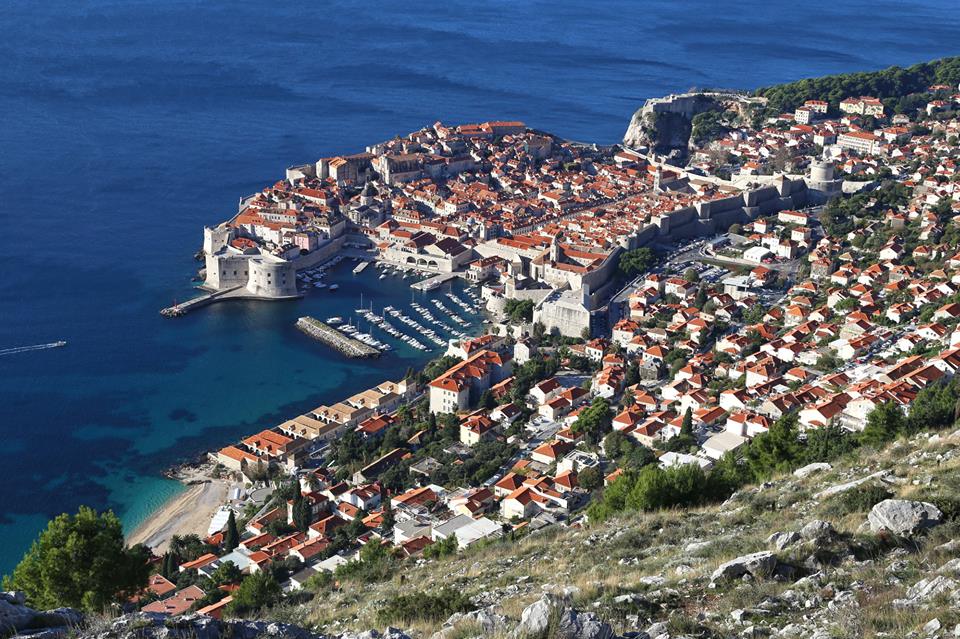
TZ Dubrovnik
To understand just why Dubrovnik has so much heritage and how it has been so well preserved, let’s take a look into this remarkable city's very long history.
The Dubrovnik Republic, which represents the golden period of Dubrovnik's history, perfectly regulated the city and life within it through its statute and other historic documents. This well-preserved city has been able to afford to lie on its Laurels owing to this, as well as its good geographic location and economy which was for centuries based on maritime and merchant activities.
The latest archaeological research discovered that there was a settlement dating back to the sixth century at this location, and this expanded with the arrival of Croats in the seventh century.
Travel and traffic between east and west during and after the Crusades resulted in the development of maritime and merchant centres in the Mediterranean and Adriatic in the twelfth and the thirteenth centuries. Another important event in the history of Dubrovnik was the Zadar Treaty, which in 1358 liberated Dubrovnik from Venetian rule while other Dalmatian towns fell under Venetian rule in 1420 and remained under their control up until the end of 18th century.
This is the reason why Dubrovnik was able to develop much more quickly than the other Dalmatian towns.
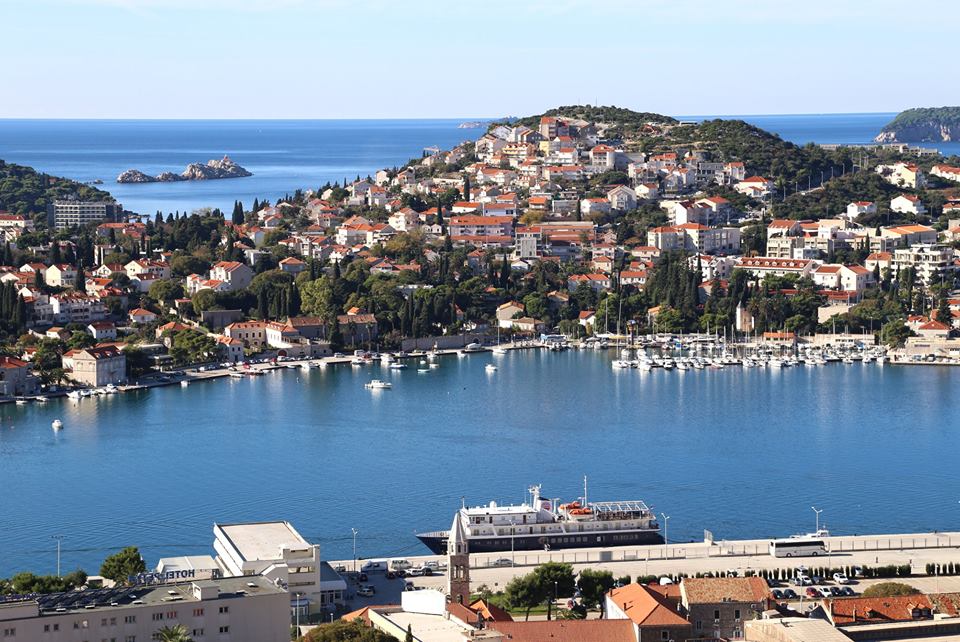
TZ Dubrovnik
In the fourteenth and fifteenth centuries, Dubrovnik was one of the most significant maritime and mercantile centres of Adriatic together with Venice and Ancona. Dubrovnik expanded its territory by using contracts and purchasing the land around the town including the islands, such as Mljet, Lastovo, the Elaphites, and of course Lokrum. The independence of the Dubrovnik Republic was completed by the fifteenth century when they had the independent election of the rector and council, and set their own currency, their own state flag with the image of St. Blaise, independent legislature and the right to establish consulates abroad.
The state authority was based on the great council which had members of aristocratic families in it. They appointed the members of the Senate and the small council which was the executive body of the great council. The rector was appointed on a monthly basis as a nominal symbol of authority.
In the fifteenth century, Dubrovnik had a well-organised transit trade route with the Balkan inland. In 1525, due to the Ottoman expansions in the area, the Dubrovnik Republic decided to pay tributes to the Ottomans and in return, they had the right to free trade throughout the growing Ottoman empire. The Dubrovnik Republic had no army on its own but managed to preserve its independence by being neutral in international conflicts and using the tutelage of powerful countries. The only rival of the Dubrovnik Republic was the envious Venetian republic.
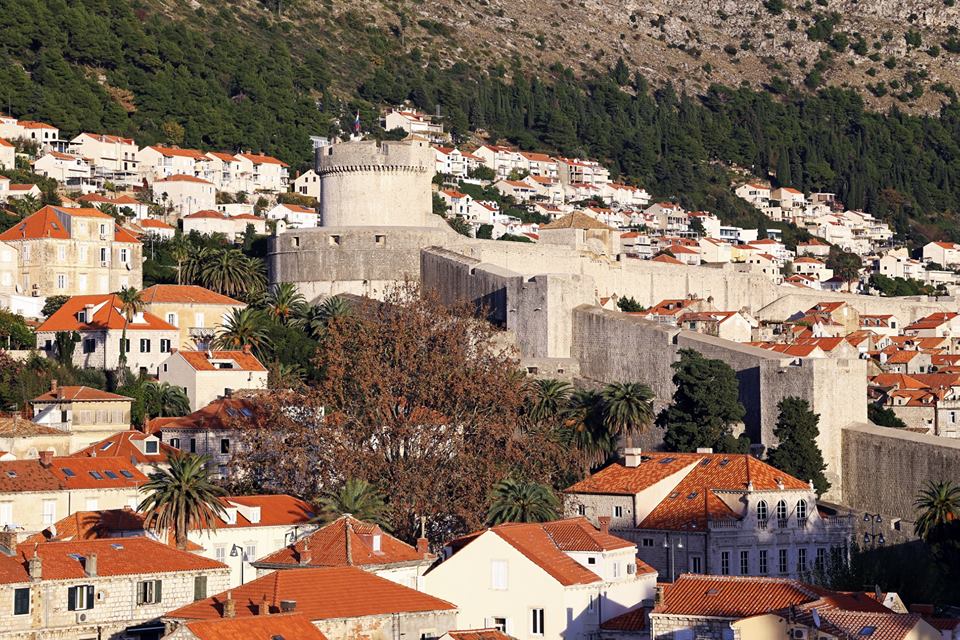
TZ Dubrovnik
The Dubrovnik Republic's golden age started in the sixteenth century – back then, Dubrovnik's merchant navy matched those across the rest of the globe with its quality fleet of 180 to 200 ships. These ships were used for long and dangerous journeys through the Mediterranean and the Black sea, as well as ocean journeys to northern ports in England and Germany, even going as far as India and the Americas. Material prosperity helped to shape a humanist culture and the Republic received a great level of achievement in its urban and architectural development that has been maintained to the present day in its literature and poetry, sciences, and in many other fields of art and culture.
In the seventeenth century, the general crisis of the Mediterranean maritime affair also affected Dubrovnik's maritime trade. The catastrophic earthquake in 1667 was another awful event for the Dubrovnik Republic. In the eighteenth century, Dubrovnik got another chance at the economic revival of maritime trade under a neutral flag. In 1815, Dubrovnik joined other parts of Dalmatia and Croatia. In more recent history, Dubrovnik was damaged during the Homeland War, with the worst attack happening on December the 6th, 1991.
Now, let's see what can be found in Dubrovnik when it comes to valuable heritage which has been recognised by UNESCO and numerous people who visit Dubrovnik each year.
Dubrovnik's City Walls

TZ Dubrovnik
Dubrovnik's city walls were established in the thirteenth century and were systematically and continuously perfected over several hundred years, until 1660, when the last tower, the St. Stephen’s Bastion, was finished. The walls stretch for over 1940 metres and consist of the main wall, sixteen towers, three forts, six bastions (bulwarks), two corner forts (cantonatas), three pre-walls with several turrets, three moats, two barbicans, two drawbridges, and one breakwater.
This is one of the best-preserved fortification systems in Europe with three forts: Minčeta, Bokar and St. John. The walls are up to 22 meters high in some places, with a thickness of between 4 to 6 meters from the mainland side, and from 1/5 to 3 metres on the seaside.
Among the many known and unknown builders of the wall and its construction, some of them are: Paskoje Miličević, Nicifor Ranjina, Marin Držić, Župan Bunić, Miho Hranjac, Juraj Dalmatinac, Michelozzo di Bartolomeo Michelozzi of Florence, Onofrio and Simeone Della Cava, Antonio Ferramolino of Bergamo, Giovanni da Siena, Bernardino di Parma, Marcantonio Bettaci of Florence, Seporoso Mateucci of Fermo and Giovanni Baptista Zanchi of Pesaro.
The shape of the walls was definitely defined by available weapons of the time and the various defence techniques of the past. The first walls were built when the first settlement was consctructed back in the eighth century, and Dubrovnik enjoyed the natural protection of the sea, with the walls acting as additional protection for Dubrovnik's citizens.
You can enter Dubrovnik's city walls next to Pile Gate, St. John's Fort and St. Luke's Fort.
Minčeta Fortress
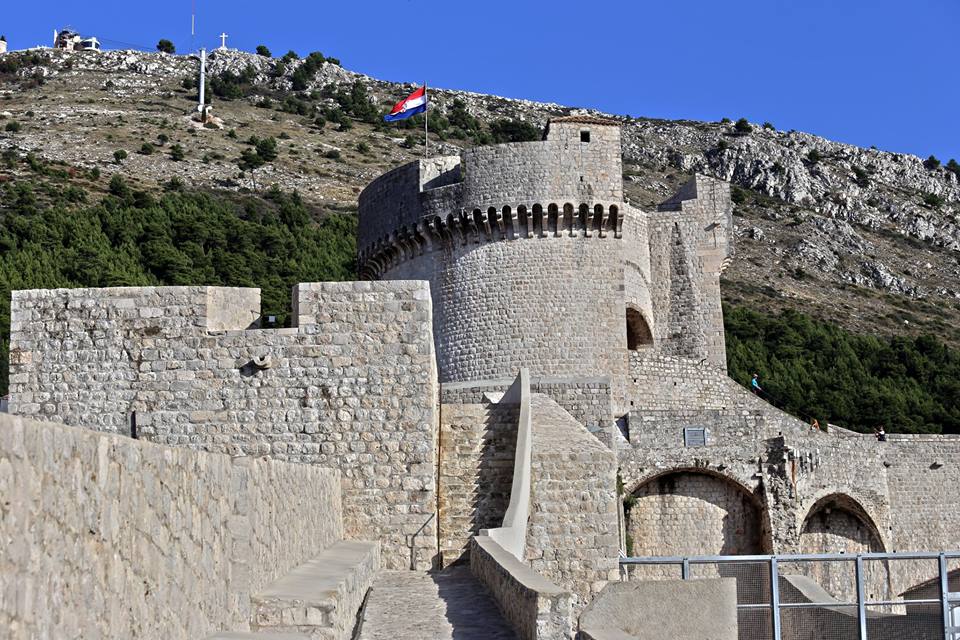
TZ Dubrovnik
Minčeta fortress is placed on the highest north-western part of the city. It is a large circular tower with a big battlement suspended by a stone support. The first quadrangular tower was constructed by Nikifor Ranjina in 1319, the architect Michelozzo Michelozzi gave it its present form and it was completed in 1464 based on the design of Juraj Dalmatinac, who was famous for numerous works in Dalmatia among which the best-known is the Šibenik cathedral, another UNESCO world heritage site.
St Luke’s Tower

TZ Dubrovnik
If you walk eastward along the city walls towards Ploče gate, you will get to St. Luke’s tower. In 1467. Paskoje Miličević designed the bulwark for the old St. Luke’s tower with openings for cannons. The tower controlled the access to the harbour.
St John's Fort
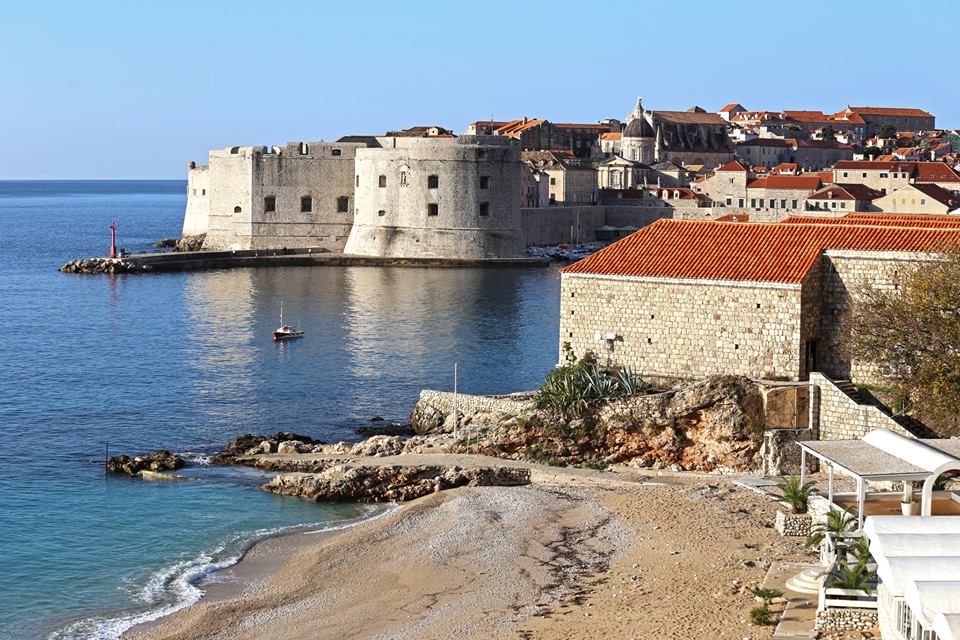
TZ Dubrovnik
This is the first quadrangular pier tower and it was constructed back in 1346 in order to protect the city harbour in the southeast, and its outlines are still visible on the western wall. The shape of the fort we know today was completed in the sixteenth century when the whole complex got bigger and outer wall was extended.
Bokar Fort
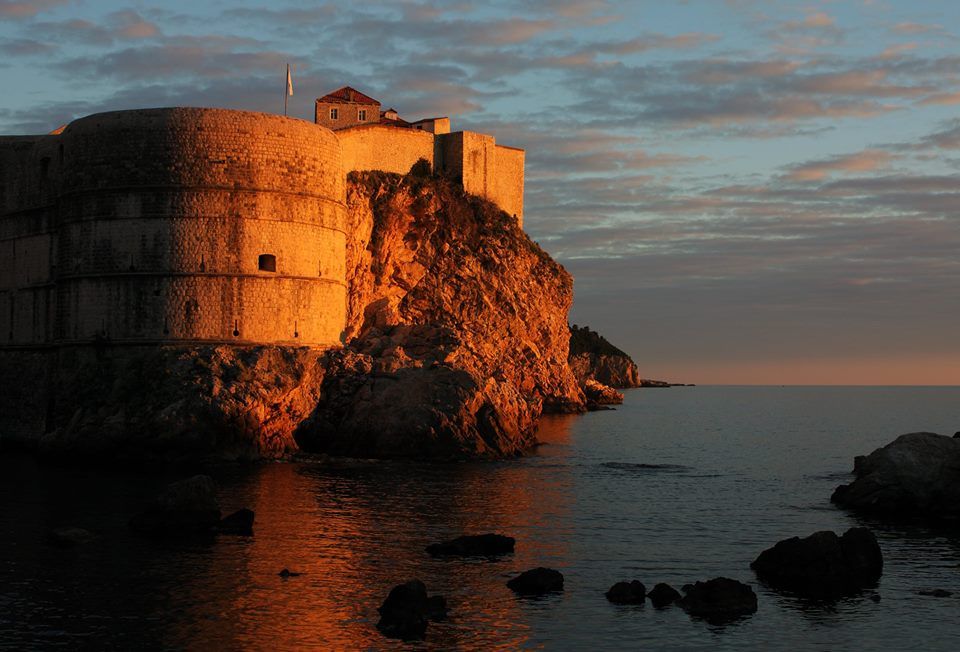
TZ Dubrovnik
This fort was important for defending the city. The gate and the bridge, as well as the moat are located at Pile. The semi-circular tower was designed by Florentine architect Michelozzi in the fifteenth century.
Lovrijenac
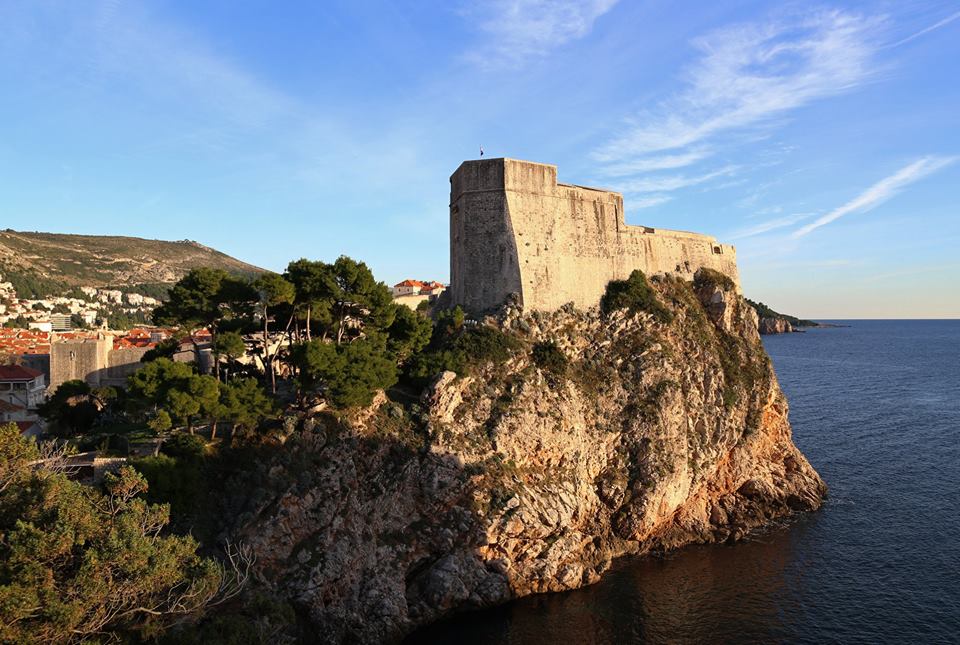
TZ Dubrovnik
This fort is set on the 37-metre-high cliffs outside of the city walls. You can reach it by walking along Pile bay and climbing the steep, stone stairs. This fort was built to protect the entrance to the city from the west. The fort's construction began in 1018 and it was completed in the sixteenth century. The walls are 4 to 12 metres thick. The entrance door boasts the Latin inscription: Non bene pro toto libertas venditur auro (Freedom is not sold for all the gold in the world). There lies the chapel of St. Lawrence and its courtyard where occasional performances and plays are held today.
Revelin Fort
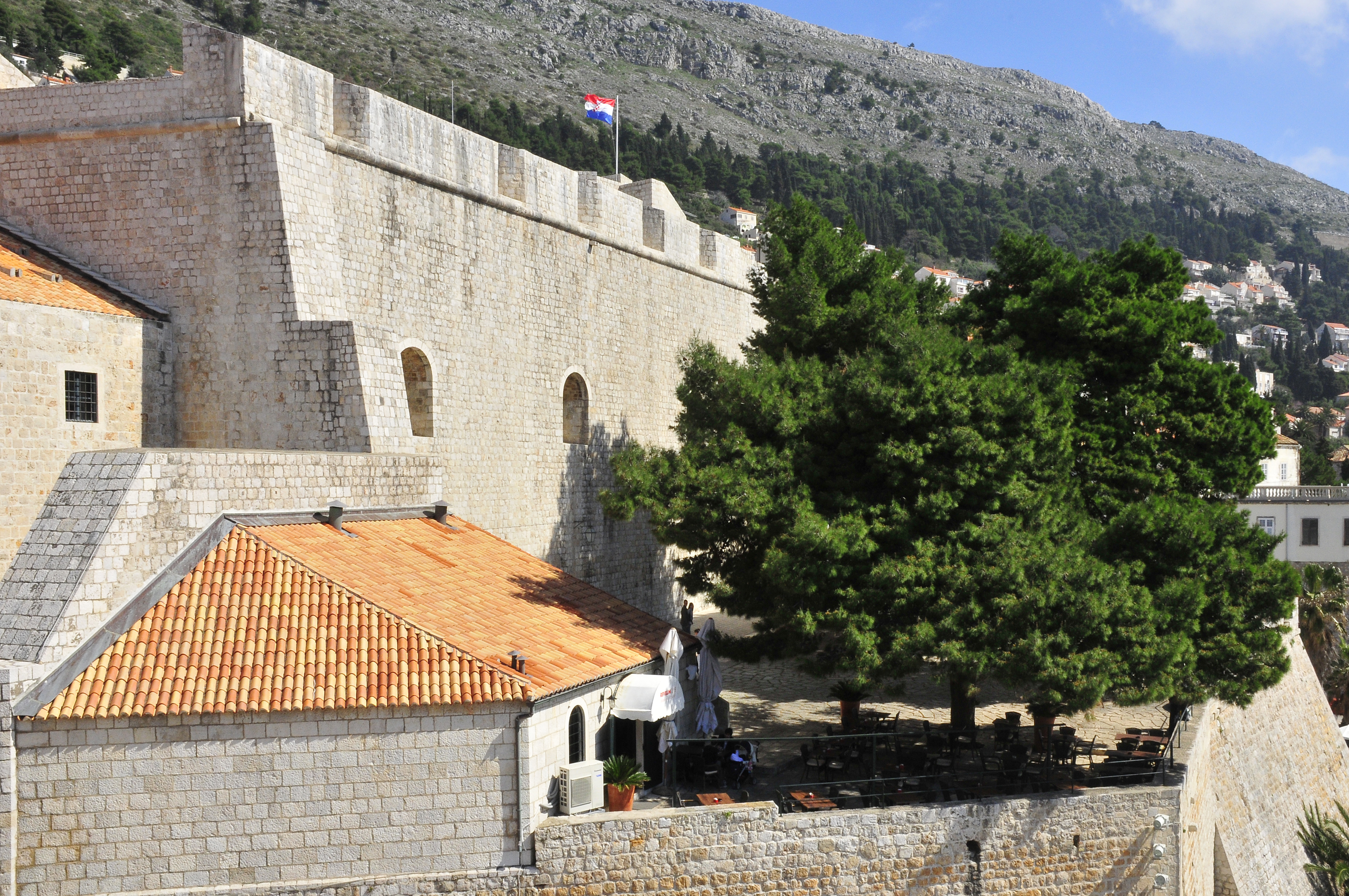
LBM1948
Revelin fort was built outside of the city walls and it was once part of the defence complex of Ploče Gate. The lower part of the fort was built in 1463, and was then rebuilt in 1538. The fort protected the eastern part of the city and the entrance to the city harbour. It has three entrances and is surrounded by a moat and the sea on three sides. Ivan Rabljanin kept the foundries for casting cannons and bells in the large interior. Now it is used as a place for Dubrovnik summer festival plays.
Pile Gate
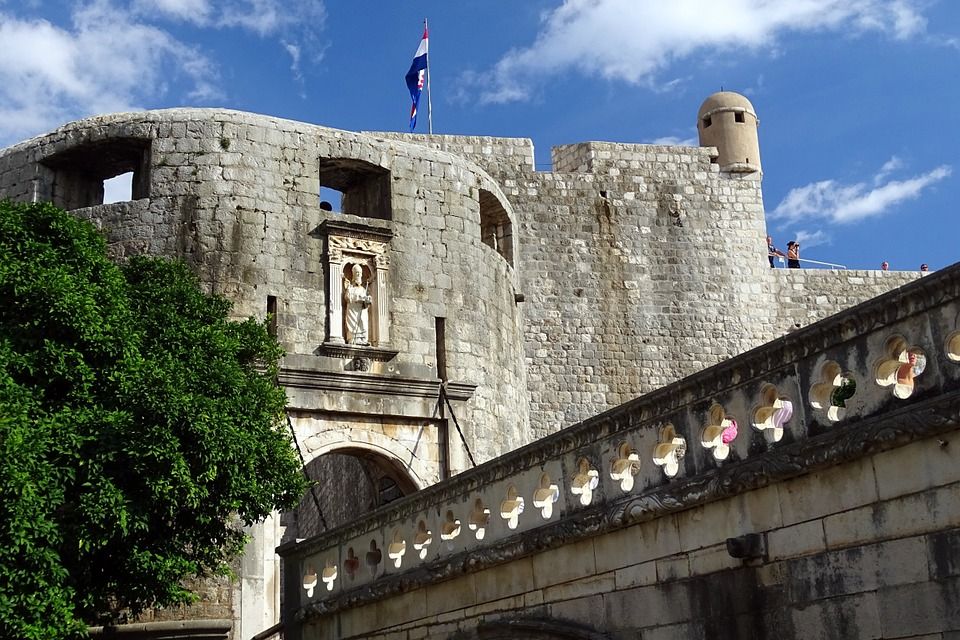
Pixabay
Just outside the city walls lies Pile – here, you first have the seaside promenade constructed outside of the walls. Here you enjoy an amazing view of the city walls and of Lovrijenac fort. If you enter the city through Pile Gate, the first thing you will see is the stone statue of St. Blaise. There is a stone bridge and a wooden bridge which lead to the outer gate, then to the renaissance semi-circular tower. When you pass through the inner gate, you enter Dubrovnik's main street – Placa or Stradun.
Stradun
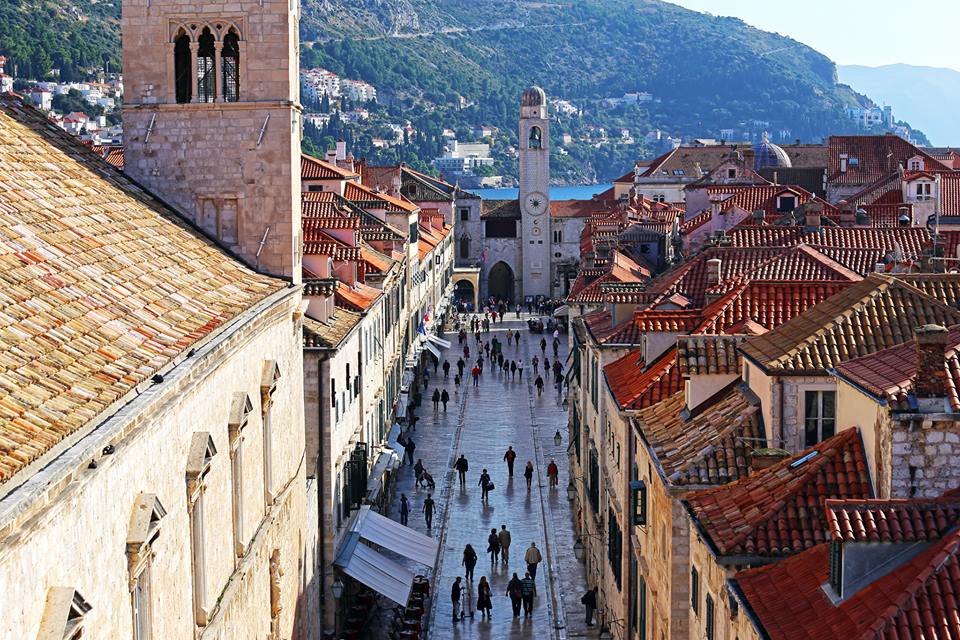
TZ Dubrovnik
Placa or Stradun is the main street in Dubrovnik. Stradun is 298 metres long and the statute of the city from 1272 determined the final plan for the city and its main street. The houses on Stradun are built in baroque-style architecture with shops on the street level. Stradun has its modern-day shape after the earthquake in 1667, when a large number of gothic and renaissance palaces were sadly destroyed. Even today, Stradun is the main centre for all the events in the town.
Large Onofrio's Fountain
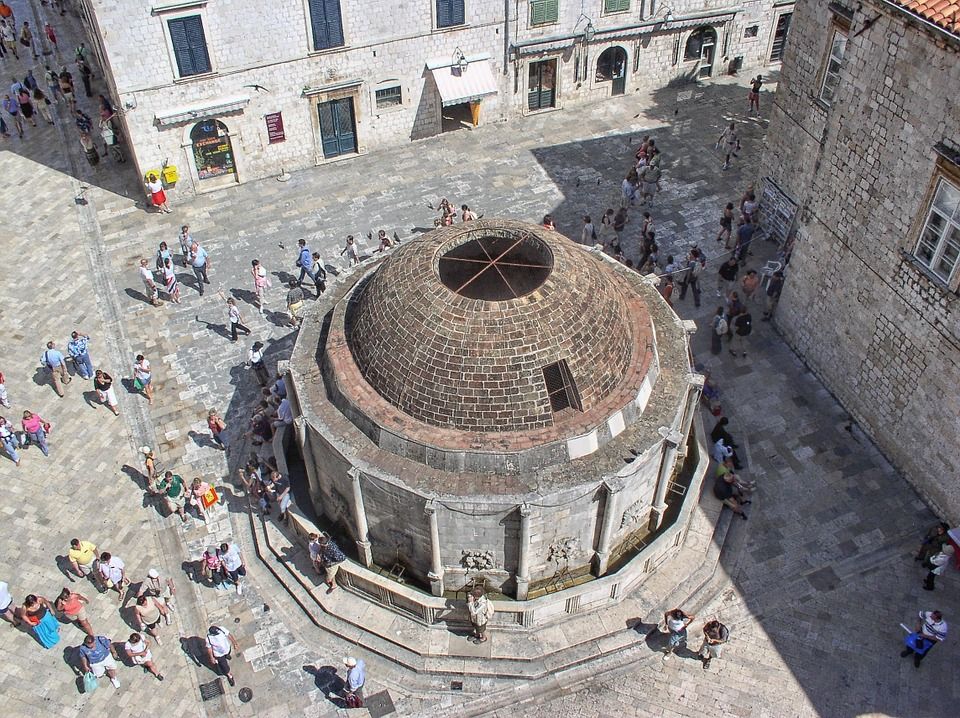
Pixabay
When on Stradun, one of the main sights is the large Onofrio's fountain. This is a large polygonal fountain with sixteen stone carved maskerons which provide running water. The fountain was designed by Onofrio Della Cava who also designed the small fountain at the other end of Stradun – the fountains were built for public use in 1438 when fresh water was brought to the city from Rijeka Dubrovačka. The fountain is now connected to the new waterworks system. The cupola was damaged during the 1667 earthquake and later reconstructions sadly failed to restore it.
Small Onofrio's Fountain
Sailko
Small Onofrio's fountain was designed in 1446 and the stone mason work was handled by Pietro di Martino di Milan. Located in a niche to the city guard building, it is part of the original setting for the carnival play “The tale of Stanac” by the famous Dubrovnik playwriter Marin Držić.
City Guard Building
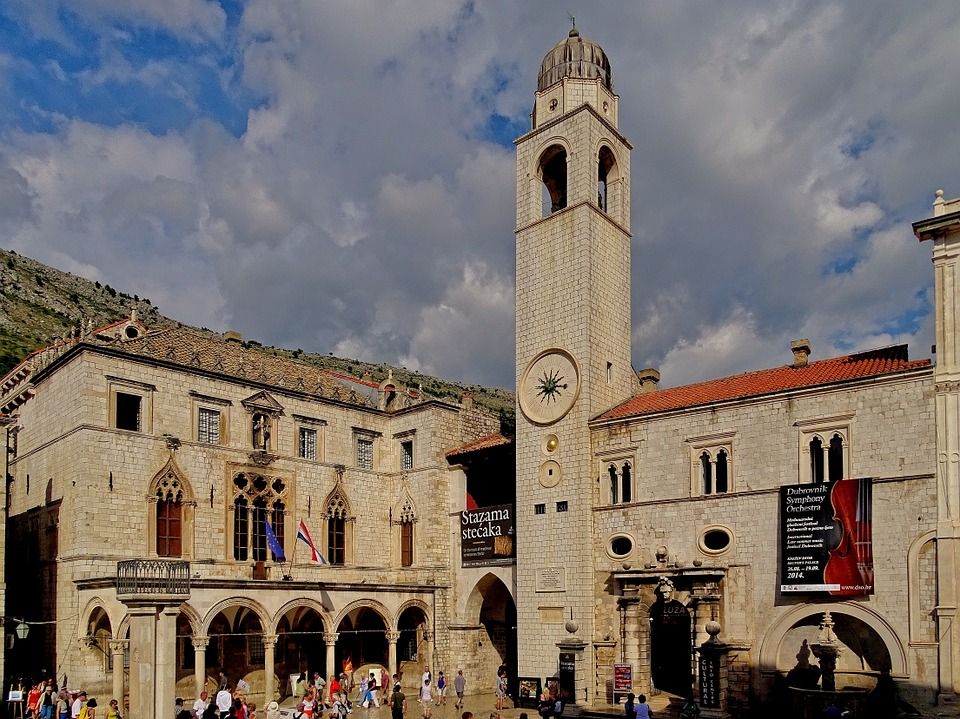
Pixabay
The City Guard building was the admiral’s residence during the fifteeth century. It was restored in the twentieth century and it is now the entrance to the cinema.
Rector's Palace
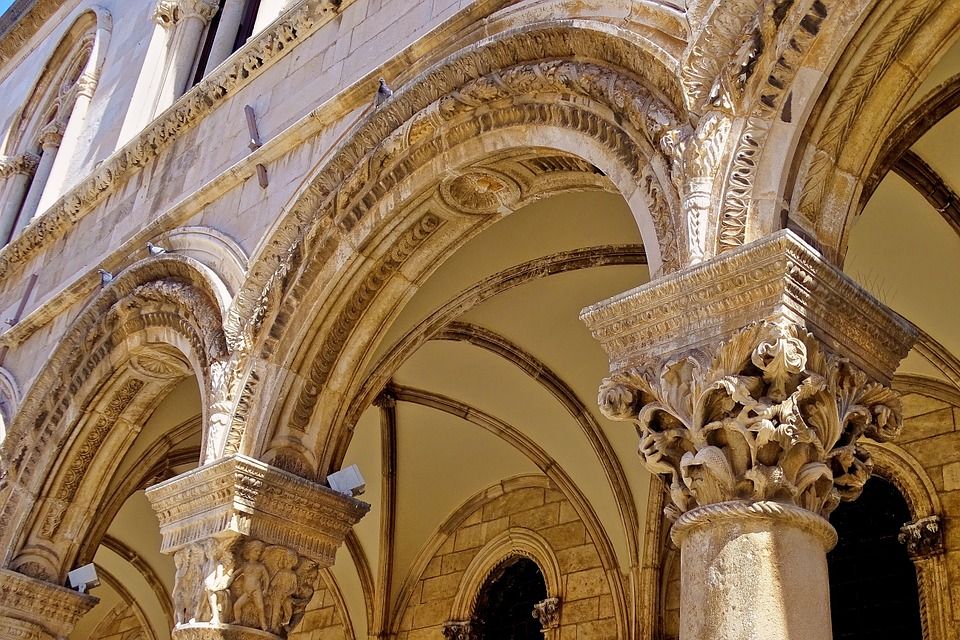
Pixabay
The Rector's Palace is one of the most important pieces of heritage on the Croatian coast – this was the administrative centre of the Dubrovnik Republic – it is built in a gothic style with reconstructions in renaissance and baroque style. It was damaged in the fifteenth century by gunpowder explosions and restored by Onofrio Della Cava in late gothic style in 1435. The second gunpowder explosion in 1463 destroyed the western facade
and the two famous architects Juraj Dalmatinac and Michelozzo worked on reconstruction. After the earthquake, the atrium was partially reconstructed with a baroque staircase. During his one month mandate, the rector lived in the palace which was the place of both the minor and major council hall, the rector’s residence, the city's courtroom, the administration office(s), the prison, and even for arsenal and gunpowder storage.
Above the entrance door lies the inscription: Obliti privatoru publica curate (Forget your private business, concern yourselves with public affairs).
In the atrium sits the bust of a rich sea captain and benefactor, Miho Pracat, this work was done by P. Giacommetti in 1628. The Miho Pracat statue is the only statue in the city for the common people – The former Dubrovnik Senate decided to do this 1638. The bust is placed between two columns in the eastern wing of the Rector's palace atrium. He was not only a rich seaman who left his wealth to the Republic, but a ship owner and a very skilled merchant. This was an enormous honour as the Dubrovnik Republic never built statues for its contemporaries, and found it inappropriate to have statues in public places. Today, the Rector's Palace is the home of the Dubrovnik museum.
Ploče Gate
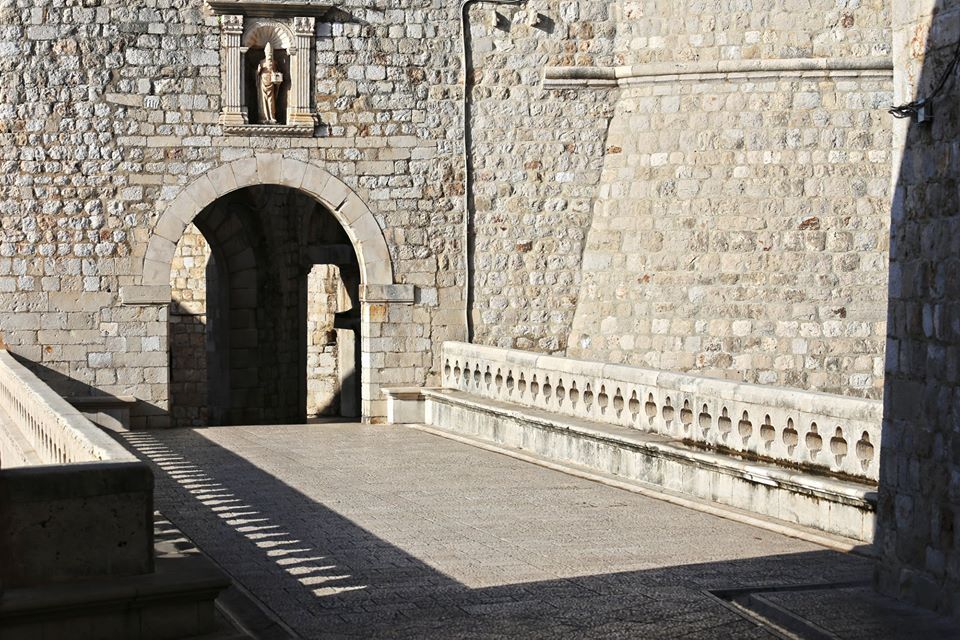
TZ Dubrovnik
Ploče gate is the eastern entrance to the city. When you pass through this gate, you will see two small churches. This entrance is fortified and had inner and outer gates with stone bridges from the fifteenth century onwards, and there lies a statue of St. Blaise, the city's patron saint.
Luža and the City Bell Tower
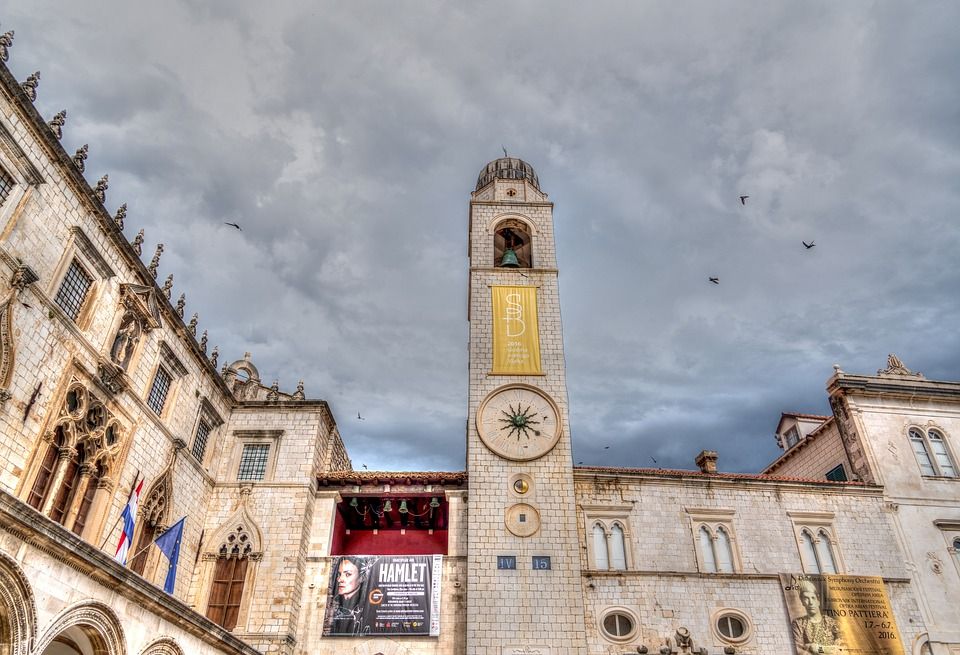
Pixabay
After passing through Ploče gate, you will end up in front of Luža and the City Bell Tower. The bell tower, built in 1444, once had figures called Zelenci who struck each hour with their hammer. The bell tower was damaged in the earthquake and it was rebuilt in 1929, while the Zelenci figures were replaced with replicas.
Sponza Palace
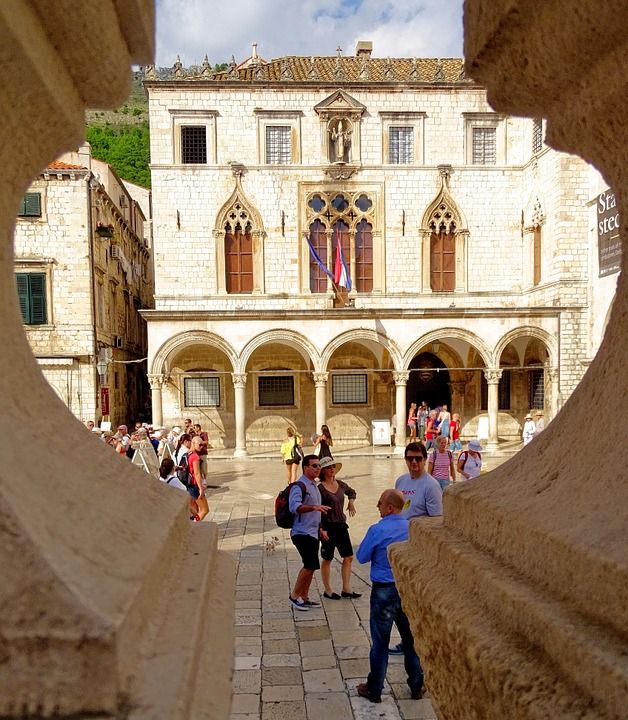
Pixabay
Right next to the bell tower lies Sponza Palace. This building is the best example of Dubrovnik's highly specific gothic-renaissance style. It was constructed in the sixteenth century based on the design of Paskoje Miličević. It was built in a rectangular shape and has a portico and an atrium. On the main wall lies the inscription: Fallere nostravetant, et fall pondere, meqve pondero cvm merces ponderat ipse deus (We are forbidden to cheat or falsify measures and when I weigh goods, God himself is weighing them with me).
This was the liveliest commercial centre of the city and in the seventeenth century, it became the meeting point for members of the Academy who discussed literature, the arts, and science. Today, it’s the home of the Dubrovnik archives.
Church of St Blaise
TZ Dubrovnik
The Church of St. Blaise is one of the most important buildings in Dubrovnik. St. Blaise is the patron saint of Dubrovnik who has been celebrated every year on February the 3rd, and this festivity is part of the city's UNESCO intangible heritage. The church got its present form is from 1715 and is a shining example of Venetian Baroque. It was built by Marino Gropelli upon the request of the Dubrovnik Senate. It was damaged in the earthquake, and then again in the fire in 1706.
In that fire, everything was destroyed except the silver statue of St. Blaise. This statue was then kept in the small church of St Nicholas on Prijeko before being brought back to its original place in 1715. This statue is one of the most valuable sculptures in Dubrovnik and the saint holds the city model, from which one can see how Dubrovnik once looked long ago. St Blaise has been being celebrated in Dubrovnik from the tenth century onwards, when he saved the people of Dubrovnik from a surprise Venetian attack with a solemn warning.
Orlando’s Column
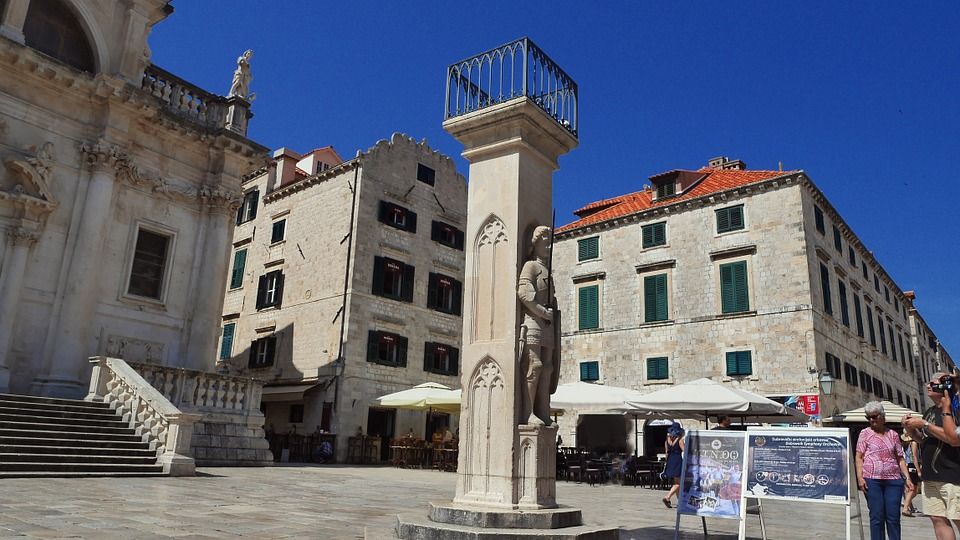
Pixabay
In front of the Church of St. Blaise lies the most important symbol of statehood and freedom for Dubrovnik – Orlando’s column. Orlando’s column was constructed by Bonino di Jakopo and Antun Raguso. Erected in 1419, Orlando’s column, with the statue of a medieval knight, stands in the square and presents Roland, the eighth-century knight from the Chanson de Roland. The reason this statue is in Dubrovnik is probably because it was brought by King Sigismund, a Hungarian and Bohemian king who was the patron of Dubrovnik Republic.
Additionally, there is a legend that says Roland saved Dubrovnik from Saracens and defeated them near the island of Lokrum. Senate decisions were announced in front of it. This statue was also a punishment spot and a pillar of shame. The white flag of the Dubrovnik Republic with the image of St. Blaise remained on the column until the abolition of the Republic in 1808. Now the Croatian flag flies there, and the flag is changed only during the Festivity of St. Blaise and during the Dubrovnik summer festival. This year, Dubrovnik is marking the 600th anniversary of the construction of Orlando’s column, and therefore 2019 is considered to be the year of Orlando.
Buža Gate
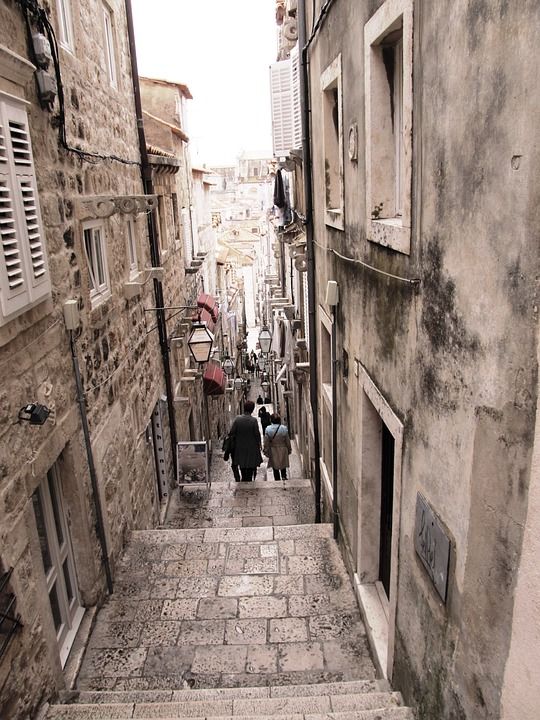
From Prijeko to Ruđer Bošković street (the place where the famed eighteenth century Croatian scientist, physicist, astronomer, and poet was born) stands the gate that was built back in 1907.
Gundulić Square
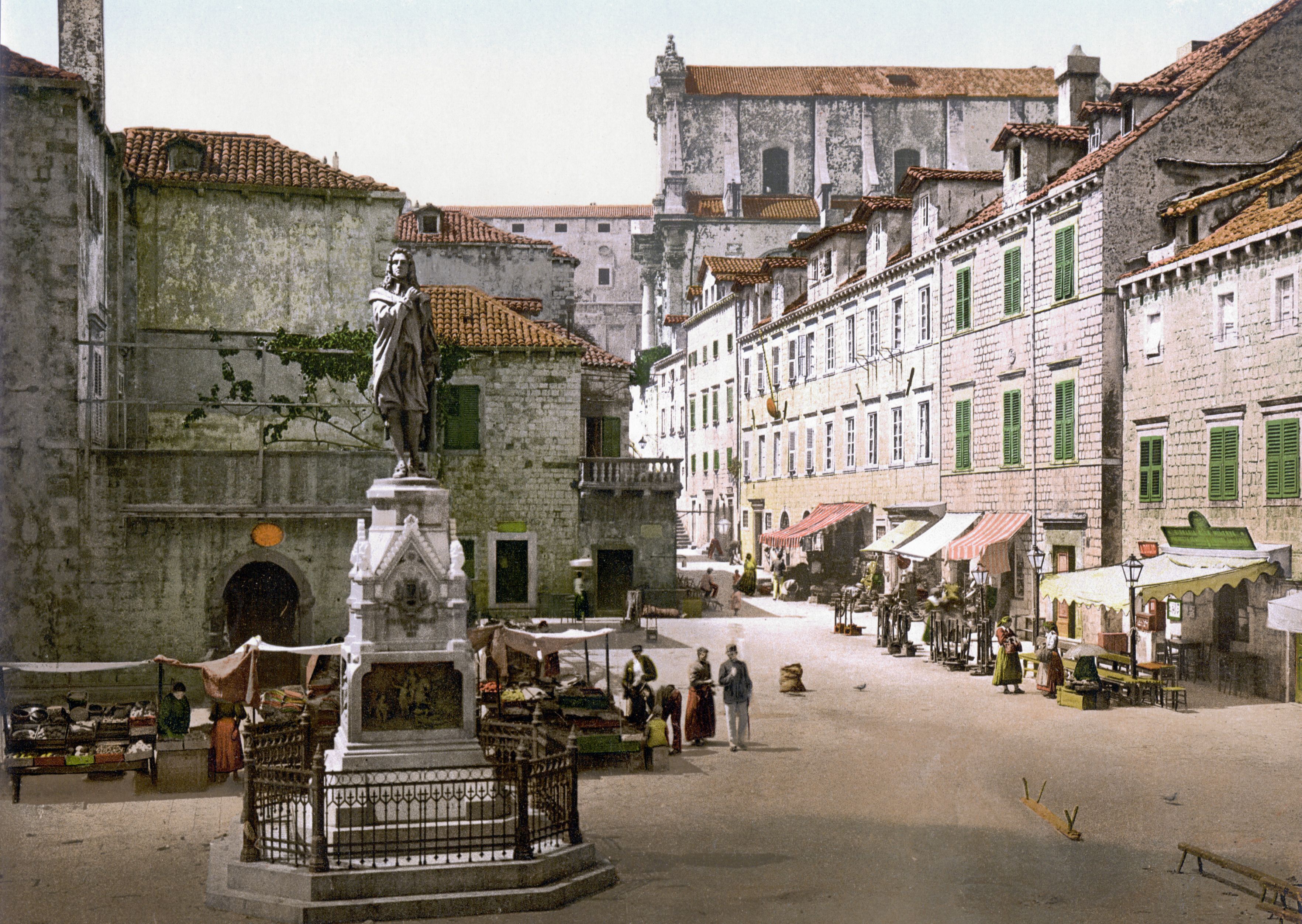
Behind the cathedral lies Gundulić square which is home to the statue of Ivan Gundulić, one of Dubrovnik's best eighteenth-century poets – this statue is the work of Ivan Rendić, and on the base of the statue there are bronze relives with scenes from Gundulić's epic poem - Osman. Ivan Gundulić was born in 1589 to an old and respectable aristocrat family. He later became famous on his own merit for his valuable works. This is the place where the green market in the morning sets up. What is interesting is that in front of the statue there are hundreds of pigeons waiting for their meal every single day – the city funds ten kilos of corn to feed the pigeons.
Jesuit Church
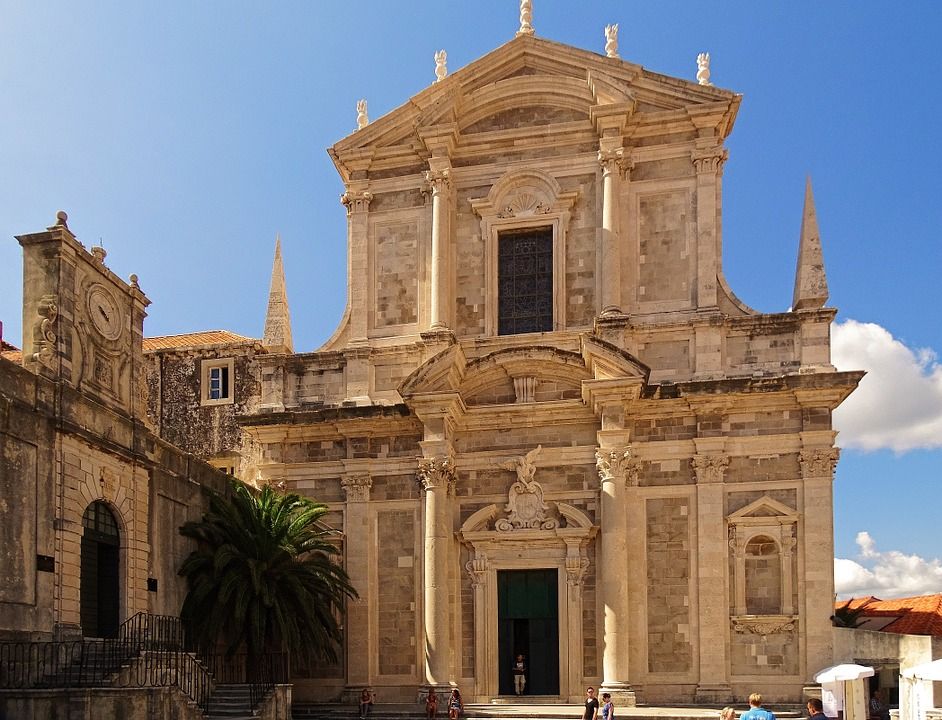
Pixabay
From there, if you go up the baroque stairs you will reach the Church of St. Ignatius or Jesuit church which is the home of Dubrovnik's most beautiful baroque complex. This church is the work of Ignazio Pozzo and right next to it is Collegium Ragusinum, the famous Jesuit school. Collegium Ragusinum was initially founded because the people of Dubrovnik were dissatisfied with their Italian teachers. The first steps for this to happen were initiated in the sixteenth century but it wasn't until the end of seventeenth and the beginning of the eighteenth century that works started. Collegium Ragusinum hosts a massive 10,000 volumes with incunabula and manuscripts by Dubrovnik's numerous writers.
City Harbour
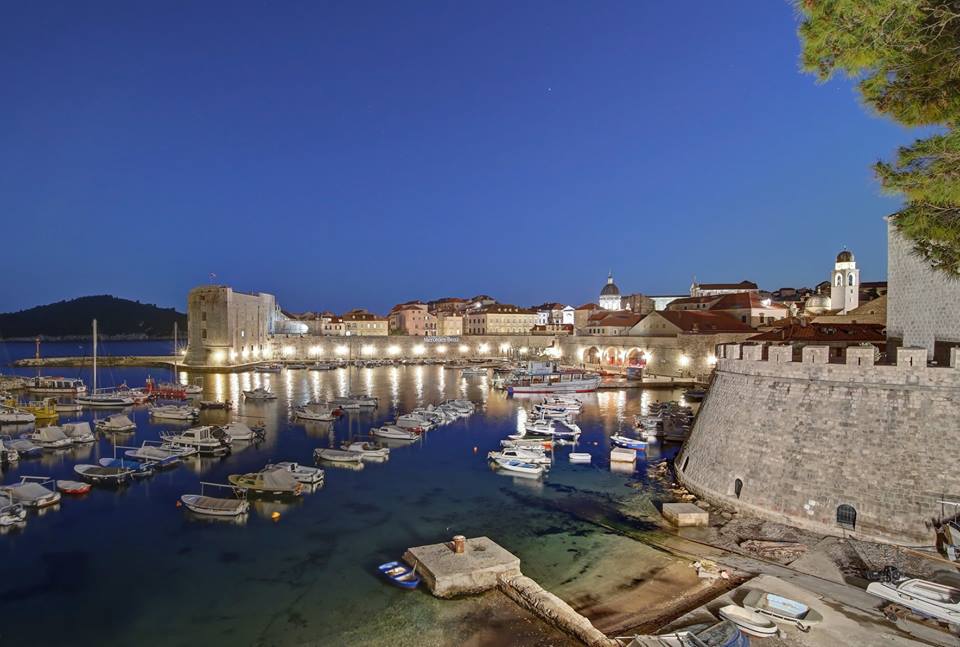
TZ Dubrovnik
The city harbour got its look back in the fifteenth century - the most recognisable part of it is the three arches of the large arsenal. East from the large arsenal there is the fish market gate and then three arches of small
arsenals where smaller ships were repaired. At the location of the large arsenal today lie the city cafe and the theatre.
Lazarettos
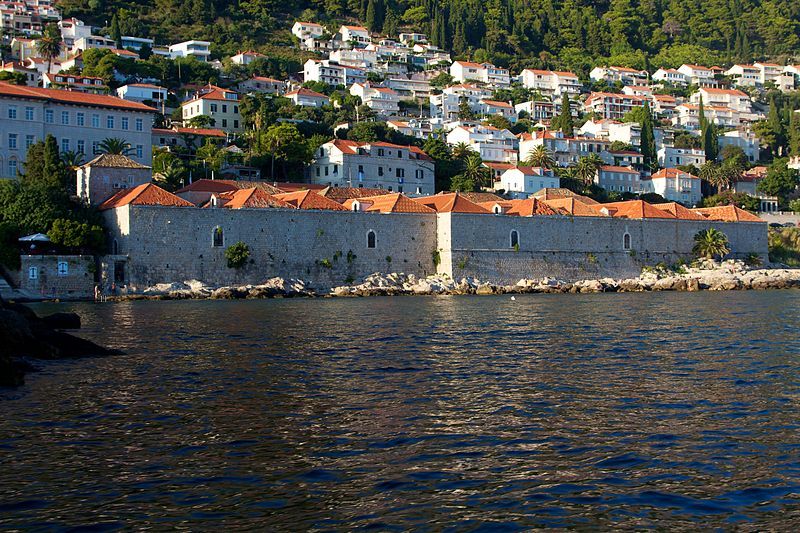
Ramon
Lazarettos (Lazaretti)
This was the place for the first quarantine built in the fourteenth century in order to isolate travellers and goods from eastern countries. There were eight buildings and five courtyards which were renovated in the sixteenth century. This complex included large warehouses and lodging for the extended stay of merchants and travellers. In the seventeenth century, this was the largest merchant transit centre on the Adriatic and one of
the best-organised quarantines in the entire Mediterranean.
With this sheer amount of invaluable heritage that is still standing today after all these centuries, Dubrovnik definitely deserves to be considered one of the greatest towns in the world, and its popularity in terms of tourist visits and global interest is very much understandable.
Young Hunter Films Three Wolves in Split-Dalmatia County
There are three types of large animals living in the Republic of Croatia, the Eurasian lynx, the bear, and the wolf. While these animals do their best to stay well away from human interaction of any kind, there are rare occasions when they make an appearance a little too close to comfort, and even a little too close too home. One young hunter spotted three wolves drinking water in Lovreć, Split-Dalmatia County, causing a panic among locals.
While wolves have been protected in Croatia since 1995, they still carry their fearsome reputation, which may likely be uncalled for. Since these pack animals prefer to stay as far from the spotlight as possible, rarely coming into any form of contact with humans or human settlements, they aren't a common sight. Sadly, when they are seen more than once in an area close to humans, people begin to worry.
As Slobodna Dalmacija/Mladen Nejasmic writes on the 2nd of February, 2019, in the area of Sidoča, in the place called Pozicija near the hamlet of Čolckušići in the Municipality of Lovreć in Split-Dalmatia County, young hunter Marijan Petričević managed to capture a rare video of a small group of wolves, consisting of what appear to be three adult individuals, drinking water on from a quagmire area designed for wild pigs.
The unusual and somewhat alarming picture immediately spread like wildfire across social networking sites, making the small group of Lovreć wolves become big news for a short time.
Many residents of that area claim that those three wolves are part of a larger pack which seem to have territory in the Kamešnica - Zavelim - Sidoč - Biokovo area, and that they are seen more often than usual in these dreary winter conditions.
Because of the large number of predators, the number of wild pigs has been reduced, a situation which is likely to upset hunters who make a living, or who simply live off their meat.
What is worrisome to the locals of Lovreć and other border areas in Split-Dalmatia County is the fact that hunters operating within this region have spoken about the constant presence of about a dozen wolves living permanently in that area.
Make sure to stay up to date with our dedicated lifestyle page for more.
Click here for the original article by Mladen Nejasmic for Slobodna Dalmacija

